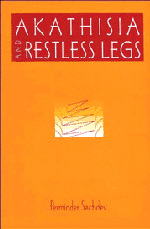Book contents
- Frontmatter
- Contents
- Foreword
- Acknowledgements
- Abbreviations
- Part I Introduction
- 1 Akathisia: development of the concept
- 2 The anatomy of restlessness
- 3 Neuroleptic-induced dysphoria
- Part II Drug-induced akathisia
- Part III Restless legs syndrome
- Part IV Conclusions
- Appendix A Haskovec's Akathisie
- Appendix B Prince Henry Hospital Akathisia Scale
- Appendix C Barnes (1989) Akathisia Rating Scale
- Appendix D Hillside Akathisia Scale (version 4)
- References
- Index
3 - Neuroleptic-induced dysphoria
from Part I - Introduction
Published online by Cambridge University Press: 12 September 2009
- Frontmatter
- Contents
- Foreword
- Acknowledgements
- Abbreviations
- Part I Introduction
- 1 Akathisia: development of the concept
- 2 The anatomy of restlessness
- 3 Neuroleptic-induced dysphoria
- Part II Drug-induced akathisia
- Part III Restless legs syndrome
- Part IV Conclusions
- Appendix A Haskovec's Akathisie
- Appendix B Prince Henry Hospital Akathisia Scale
- Appendix C Barnes (1989) Akathisia Rating Scale
- Appendix D Hillside Akathisia Scale (version 4)
- References
- Index
Summary
One must be crazy, either literally or figuratively, to take these drugs [neuroleptics].
Leo E. Hollister (1992)Neuroleptic drugs are unpleasant for both normal people and many psychiatric patients, and this behavioural side-effect has been recognized from the time these drugs were first introduced. Hollister (1957) cited a study in which 80 normal individuals were given a single 50-mg dose of chlorpromazine. Twenty (25%) experienced increased fatigue, sleepiness and generally unpleasant feelings. A number of other authors have reported distressing feelings in normal people or nonpsychiatric patients in response to these drugs (Hollister, 1961; Kendler, 1976; Belmaker and Wald, 1977; Anderson et al, 1981). To quote Belmaker and Wald (1977, p. 222), who injected themselves with 5 mg haloperidol iv:
Within ten minutes a marked slowing of thinking and movement developed, along with profound inner restlessness. Neither subject could continue work, and each left work for over 36 hours. Each subject complained of a paralysis of volition, a lack of physical and psychic energy. The subjects felt unable to read, telephone or perform household tasks of their own will, but could perform these tasks if demanded to do so. There was no sleepiness or sedation; on the contrary, both subjects complained of severe anxiety.
A number of descriptions of neuroleptic-induced dysphoria (NID) in the literature suggest that only a proportion of this dysphoria is due to akathisia. It is for this reason that NID is discussed in this book separately.
- Type
- Chapter
- Information
- Akathisia and Restless Legs , pp. 47 - 60Publisher: Cambridge University PressPrint publication year: 1995



